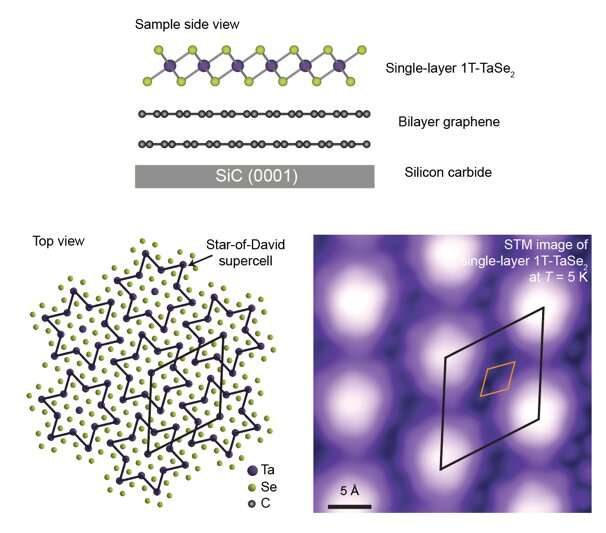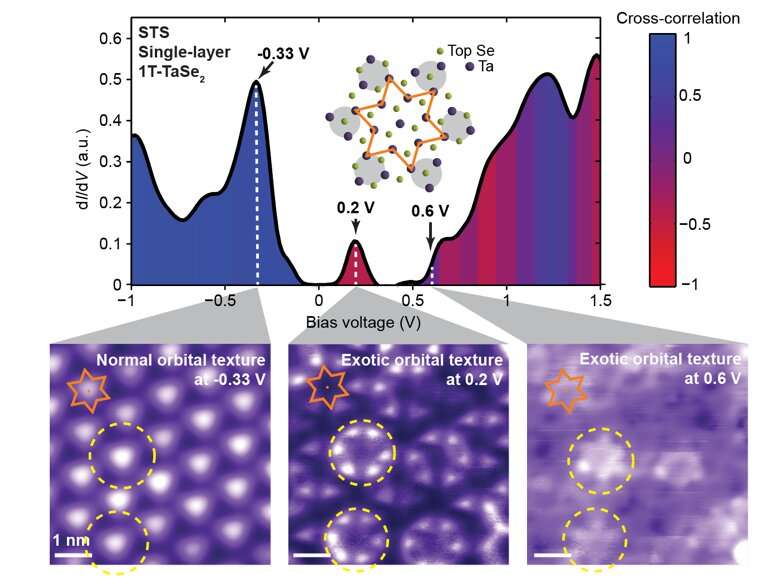January 27, 2020 feature
Researchers discover a unique orbital texture in single-layer of 3-D material

New physical behavior, such as Mott insulating behavior, unconventional superconductivity and quantum spin liquid behavior, occurs when electrons inside a material interact with each other. When electrons are confined to lower dimensions such as 2-D planes, these effects can become even stronger.
Inspired by these observations, researchers at UC Berkeley, the Lawrence Berkeley National Laboratory, Stanford University, and other universities worldwide have recently carried out a study investigating the unique behavior of two-dimensional 1T-TaSe2. Their paper, featured in Nature Physics, indicates that electron correlations in this material result in a robust Mott insulator state that is accompanied by unusual orbital texture.
"It has long been believed that the bulk (i.e., 3-D) materials 1T-TaSe2 and 1T-TaS2 exhibit novel behavior that arises from electron-electron interactions," Michael F. Crommie, one of the researchers who carried out the study, told Phys.org. "A challenge in understanding this class of materials, however, is that they are made of stacks of 2-D layers and the coupling between the layers clouds the picture for what is happening within the layers."
To overcome this challenge and in the hope of uncovering new behavior, Crommie and his colleagues decided to thin a crystal of 1T-TaSe2 down to single-layer thickness so that interactions between the different layers would no longer be an issue. This would allow them to isolate the role of interlayer coupling by adding layers back in one at a time while monitoring changes in the material's behavior.
"To follow this game plan, we grew single layers and few-layer stacks of 1T-TaSe2 and characterized how the electrons inside behave by using the experimental techniques of scanning tunneling microscopy (STM) and angle-resolved photoemission (ARPES)," Crommie explained. "This allowed us to determine that single-layer 1T-TaSe2 is a novel type of insulator called a Mott insulator, and that this behavior is quenched by interlayer coupling as more layers are added to a stack."

A part of the research team at the Advanced Light Source (ALS) at Lawrence Berkeley National Laboratory (LBNL), led by physicists Zhi-Xun Shen and Sung-Kwan Mo, grew single-layer and few-layer samples of 1T-TaSe2 using a method called molecular beam epitaxy. This method essentially consists of depositing tantalum and selenium from atomic beams onto a substrate that is heated to induce the formation of atomically thin crystals.
"The atomically thin crystals were first interrogated at the ALS by Shen and Mo's groups using ARPES, a method that involves shining X-rays onto the material and measuring the energy and momentum of the electrons that are kicked out," Crommie explained. "The samples were then brought down to the UC Berkeley campus and characterized by my research group using STM. In STM, a sharp metal needle scans the crystal surface and pulls electrons out at different energies in order to directly image how electrons arrange themselves at the atomic scale."
This collaborative research effort involving teams at multiple institutions led to a series of exciting results. First, the observations gathered by Crommie and his colleagues determined that single layers of 1T-TaSe2 form a new 2-D Mott insulator system. Second, they provided valuable insight into some of the unique behavior exhibited by the system.
"Our work establishes single-layer 1T-TaSe2 as a new 2-D Mott insulator," Yi Chen, one of the co-first authors of the paper said. "This results in the electrons in this material arranging themselves into novel spatial patterns, or textures, that have never before been seen. We also clarified the role of interlayer coupling in 1T-TaSe2 and determined that this makes it less insulating and reduces the effects of electron-electron interactions."
In addition to deepening the current understanding of 1T-TaSe2 materials and their properties, the findings collected by Crommie and his colleagues could pave the way for the discovery of unique new states of matter. The researchers are now planning to carry out further studies investigating other properties or behaviors of 1T-TaSe2 materials.
"We are excited to explore other exotic states of matter that might occur in this new 2-D Mott insulator, such as quantum spin liquid states and unconventional superconductivity," Crommie said. "We will try to characterize it and manipulate its properties further by incorporating it into new electrical devices."
More information: Yi Chen et al. Strong correlations and orbital texture in single-layer 1T-TaSe2, Nature Physics (2020). DOI: 10.1038/s41567-019-0744-9
Journal information: Nature Physics
© 2020 Science X Network



















